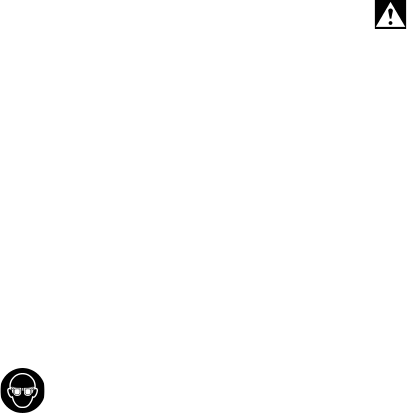
ENGLISH en
13
excessive depth of cut. Overstressing the wheel
increases the loading and susceptibility to twisting
or snagging of the wheel in the cut and the
possibility of kickback or wheel breakage.
d) Do not position your hand in line with and
behind the rotating wheel. When the wheel, at the
point of operation, is moving away from your hand,
the possible kickback may propel the spinning
wheel and the power tool directly at you.
e) When wheel is pinched, snagged or when
interrupting a cut for any reason, switch off the
power tool and hold the power tool motionless
until the wheel comes to a complete stop.
Never attempt to remove the cut-off wheel from
the cut while the wheel is in motion otherwise
kickback may occur. Investigate and take
corrective action to eliminate the cause of wheel
pinching or snagging.
f) Do not restart the cutting operation in the
workpiece. Let the wheel reach full speed and
carefully re-enter the cut. The wheel may bind,
walk up or kickback if the power tool is restarted in
the workpiece.
g) Support panels or any oversized workpiece
to minimize the risk of wheel pinching and
kickback. Large workpieces tend to sag under their
own weight. Supports must be placed under the
workpiece near the line of cut and near the edge of
the workpiece on both sides of the wheel.
h) Use extra caution when making a "pocket
cut" into existing walls or other blind areas. The
protruding wheel may cut gas or water pipes,
electrical wiring or objects that can cause kickback.
4.4 Safety warnings specific for wire
brushing operations:
a) Be aware that wire bristles are thrown by the
brush even during ordinary operation. Do not
overstress the wires by applying excessive
load to the brush. The wire bristles can easily
penetrate light clothing and/or skin.
b) Allow brushes to run at operating speed for
at least one minute before using them. During
this time no one is to stand in front or in line
with the brush. Loose bristles or wires will be
discharged during the run-in time.
c) Direct the discharge of the spinning wire
brush away from you. Small particles and tiny
wire fragments may be discharged at high velocity
during the use of these brushes and may become
imbedded in your skin.
4.5 Additional Safety Instructions:
WARNING – Always wear protective
goggles.
Use elastic cushioning layers if they have been
supplied with the grinding media and if required.
Observe the specifications of the tool or accessory
manufacturer! Protect the discs from grease or
impacts!
Abrasives must be stored and handled with care in
accordance with the manufacturer's instructions.
Never use cutting discs for roughing work! Do not
apply pressure to the side of the cutting discs.
The workpiece must lay flat and be secured against
slipping, e.g. using clamps. Large workpieces must
be sufficiently supported.
Engage the spindle lock button (4) only when the
motor is at a standstill. (GA 18 LTX, GPA 18 LTX,
GA 18 LTX G, GE 710 Plus, GEP 710 Plus,
GE 950 G Plus, GEP 950 G Plus)
Keep hands away from the rotating tool! Remove
chips and similar material only with the machine at
a standstill.
Prior to use, ensure that the abrasive media is
properly fitted and secured. Run the tool in idle for
60 seconds in a safe position and stop it
immediately in the event of significant vibrations or
other faults are discovered. If such a situation
occurs, check the machine to determine the cause.
Ensure that sparks produced during work do not
constitute a risk to the user or others and are not
able to ignite flammable substances. Areas at risk
must be protected with flame-resistant covers.
Always keep a fire extinguisher on hand when
working in areas prone to fire risk.
Damaged, eccentric or vibrating tools must not be
used.
In the interests of safety, ensure that the rubber
sleeve (3) or additional handle is fitted while
working (5).
Reduce dust exposure:
Some dust created by using this power tool
may contain chemicals known to cause
cancer, allergic reaction, respiratory disease, birth
defects or other reproductive harm. Some
examples of these chemicals are: Lead from lead-
based paints, crystalline silica from bricks and
cement and other masonry products, Arsenic and
chromium from chemically-treated lumber, hard
wood like oak or beech, Metals, Asbestos.
The risk from these exposures depends on how
long you or bystanders are being exposed.
Do not let particles enter the body.
To reduce your exposure to these chemicals: work
in a well ventilated area, and work with approved
safety equipment, such as dust masks that are
specially designed to filter out microscopic
particles.
Observe the relevant guidelines for your material,
staff, application and place of application (e.g.
occupational health and safety regulations,
disposal).
Collect the generated particles at the source, avoid
deposits in the surrounding area.
Use suitable accessories for special work (see
chapter 10.), thus less particles enter the
environment in an uncontrolled manner.
Use a suitable extraction unit.
Reduce dust exposure with the following measures:
- Do not direct the escaping particles and the
exhaust air stream at yourself or nearby persons
or on dust deposits.
- Use an extraction unit and/or air purifiers.


















